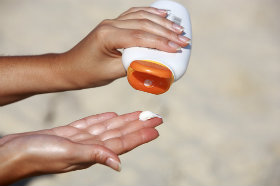How To Get The Most Out Of Your Sunscreen Using These 4 Methods
 Summer is here, and summer means vacation, sun, lazy afternoons on the lake…and sunburn. Applying sunscreen is the single most important thing you can do to protect your skin from the harmful effects of the sun. Before you and your family head outside, there are some things that you need to know about sunscreen.
Summer is here, and summer means vacation, sun, lazy afternoons on the lake…and sunburn. Applying sunscreen is the single most important thing you can do to protect your skin from the harmful effects of the sun. Before you and your family head outside, there are some things that you need to know about sunscreen.
Always check the expiry date
Your sunscreen has an expiration date. It may be two or three years from now, but you need to check the date before you use it. Signs that your sunscreen isn’t good anymore include a product that is too thick or too thin, gritty or grainy, or clumpy. If you feel like something is just “not quite right”, it’s a good idea to throw the bottle out and buy a new one.
Choose the right sunscreen type
Sunscreen works in two different ways to protect your skin. The physical ingredients reflect the light off of your skin, causing it to bounce and scatter, while the chemical ingredients actually absorb the harmful rays of the sun. Sunscreen that makes use of both kinds of protection is called “broad spectrum” sunscreen, and this is the one that is recommended for most people to use. For people with sensitive skin, chemical-free sunscreens are available that contain only the physical ingredients.
Always read the label
The label on the bottle contains a lot of acronyms. It’s important to know what they mean.
UVA is the radiation from the sun that penetrates your skin and causes it to turn tan.
UVB is the radiation from the sun that causes your skin to burn and turn red. Both kinds of rays are associated with skin damage, skin cancer and premature aging. SPF stands for “sun protection factor” and measures how well you’re protected from UVB rays. The average person begins to burn after just two minutes exposure to the sun. The SPF number tells you how many times longer you can be exposed to the sun before you start to burn.
Sunscreen has a time limit—always re-apply
To make sure that you’re truly using your sunscreen properly, it’s important to know multiple factors that can cause your sunscreen to become ineffective.
These include:
Sweat – Humid weather causes the sunscreen to slough off your skin.
Swimming – Even “water proof” sunscreen needs to be reapplied after swimming.
Drying off – When you dry off, the sunscreen comes off on your towel.
Not using enough – Most people underestimate their sunscreen needs.
It’s great to bask under the sun but always remember to protect your skin to prevent sun damage. For the best protection, you should use a broad-spectrum sunscreen with an SPF of at least 30. Check your expiration dates, and re-apply regularly to ensure that you are fully protected.
The Sooner You Know About Hyperhidrosis The Better
Our lives are normally very hectic and busy, and due to this reason, we sometimes forgo proper eating methods and simply consume food in a haphazard manner. However, this isn’t right and it could actually lead to problems with the digestive system. When this happens, you need to switch to healthier eating alternatives and habits so that you remain healthy even if you eat on the go.
Here are five ways in which you can achieve this: Is your sweating disrupting your daily routine? You could have a condition called hyperhidrosis which is often triggered by stress and results in the overproduction of sweat. It typically happens to people between the ages of 25 and 64, although younger people may be affected as well. If this sounds like you, learn the common symptoms and treatment to manage hyperhidrosis.
Common Symptoms
The main symptom of hyperhidrosis is excess sweat. It can be focalized—occurring in the feet, hands, face, armpits or other areas—or generalized, occurring over the whole body. Generalized hyperhidrosis is typically caused by an infection, chronic disease or an interruption in the processes that regulate hormones. Focalized hyperhidrosis is thought to have a genetic component, as often there is more than one person in the family with the condition.
Because hyperhidrosis causes a sheen of sweat on the hands, face, and other areas of the body, people with the condition may become self-conscious, especially in situations where touching is involved, such as hugging or handshaking. They may also avoid exercising, to avoid the embarrassment of excess sweat. In extreme cases, the condition can significantly impact a person’s ability to do their job.
Treatments Options
There are several treatments available for Hyperhidrosis, especially for Focalized Hyperhidrosis. They include the following:
Oral medications
These work by affecting the nerves that cause sweating. Side effects can include dry mouth, constipation, urinary difficulties, blurry vision and increased heart rate.
Surgical procedures
When other treatments fail to help, surgery may be necessary. By blocking the nerve receptors that cause sweating, doctors can help to reduce or eliminate the problem. Complications from surgery can include bleeding, infection and nerve damage.
Topical medications
These medications contain aluminum salts in higher concentrations than regular antiperspirants. They may cause burning or itching at the application site.
Botulinum Toxin A
This treatment involves injecting the toxin either in the armpit or palms. It’s only used for Focalized Hyperhidrosis. Side effects include pain and itching at the injection site, and headache.
Iontopheresis
This procedure involves using a medical device to pass a mild electrical current through water and the skin’s surface—utilizing shallow pans large enough for your hands or feet to fit in. With this method, no significant or serious side effects take place and the benefits are long-term, but you have to adhere to a maintenance schedule and the doctor recommended frequency is often once per week.
There is no way to prevent hyperhidrosis, however with proper treatment, the symptoms can be controlled, allowing the person affected to lead a full and productive life.


